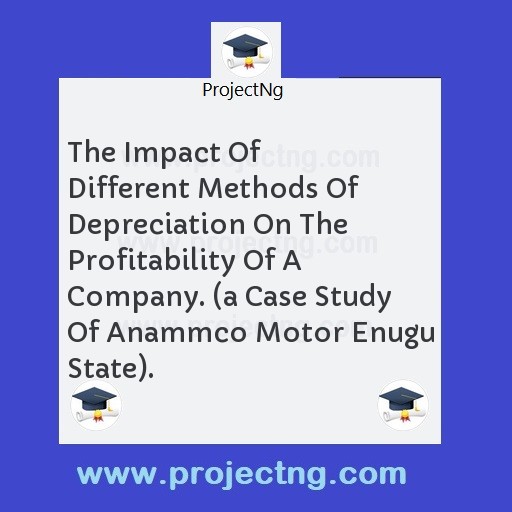The Impact Of Different Methods Of Depreciation On The Profitability Of A Company. (a Case Study Of Anammco Motor Enugu State).
Accounting Project Topics
Get the Complete Project Materials Now! »
THE IMPACT OF DIFFERENT METHODS OF DEPRECIATION ON THE PROFITABILITY OF A COMPANY.
(A CASE STUDY OF ANAMMCO MOTOR ENUGU STATE).
ABSTRACT
The main purpose of this study is to measure the impact of different methods on the profitability of accompany the differ methods of providing for depreciation has been posing a problem to many people because the understanding and the use of these methods provide varying depreciation expenses on the sane fixed asset in viler of these when profit is reported using deferred methods part the service potential of a depreciable asset is exhausted in the cost revenue generating process each period the cost of these services meets be deducted from revenue of the period in order to measure the periodic income the expired cost must be recovered before a business is considered as well as at the beginning of the period and troublesome area in accounting.
Deprecation was actually a cost of doing business executive tended to view depreciation as a matter of setting aside speciation during prosperous period for the replacement of depreciation assets.
Chapter one we examined the need for the study, finding out what impact depreciation on the company’s profitability and tax. It also looked into the significance of the study that is building funds for the study of their asset at the end of the existing asset useful life. The scope was ANAMMCO, Niger gas limited and premier Breweries Plc.
Chapter two examined and reviewed the causes of depreciation that can be physical deterioration from wear and tear, the different method of calculating depreciation. Like straight-line method, revaluation methods etc. its impact on income statement and the evaluation of depreciable methods.
Chapter three dealt with research design and methodology.
Chapter four discussed the presentation analysis and interpretation of data the different method of depreciation and tested the hypothesis stated in chapter one.
Chapter five was the findings, recommendations and the conclusion.
TABLE OF CONTENTS
COVER PAGE
TITLE PAGE
APPROVAL PAGE
DEDICATION
ACKNOWLEDEMENT
ABSTRACT
TABLE OF CONTENTS
LIST OF TABLES
CHAPTER ONE
INTRODUCTION
PREAMBLE
STATEMENT OF PROBLEMS
OBJECTIVE OF THE STUDY
HYPOTHESIS FORMULATIONS
THE SIGNIFICANCE OF THE STUDY
SCOPE OF THE STUDY
LIMITATION OF THE STUDY
DEFINITION OF TERMS
REFRENCES
CHAPTER TWO
LITERATURE REVIEW
THE NATURE OF THE DEPRECIATION
CAUSES OF DEPRECIATION
METHODS OF CALCULATING DEPRCIATION
THE IMPACT OF DEPRCIATION ON INCOME STATEMENT
EVALUATIONOF DEPRECIATION METHODS
THE CONCEPT OF PROFIT
DEFINITION OF PROFIT
THE RELATIONSHIP BETWEEN BALANCE SHEET,PROFIT AND LOSS ACCOUNT
DOPRECIATION METHOD AND MANAGEMENT DECISION
DECLINING PRODUCTIVITY CONTROVERSY
IMPACT OF INFLATION
COST OF A PLANT ASSET
ESTIMATED LIFE OF A FIXED ASSET
TERMINAL VALUE OF A FIXED ASSET
REFRENCES
CHAPTER THREE
RESEARCH DESIGN AND METHODOLOGY
INTRODUCTION
INSTRUMENT FOR DATACOLLECTION AND PROCEDURES
SOURCES OF DATA
THE SAMPLE SIZE CALCULATION AND SELECTION
VALIDITY OF THE QUESTIONNAIRE
QUESTIONNAIRE ADMINISTRATION AND COLLECTION
STATISTICAL TREATMENT
DECISION RULE
REFRENCES
CHAPTER FOUR
PRESENTATION, ANALYSIS AND INTERPRETATION OF DATA
BASES OF COMPUTION USING THE DIFFERENT METHODS OF DEPRECIATION
HYPOTHESIS TESTING
CHAPTER FIVE
FINDINGS, RECOMMENDATIONS AND CONCLUSION
FINDINGS
RECOMMENDATIONS
CONCLUTION
BIBLIOGRAPHY
APPENDIX 1
APPENDIX 2
LIST OF TABLES
COMPANY NAMES
SHOWING THE NUMBER OF THE SAMPLE SIZE
DISTRIBUTES OF QUESTIONNAIRE
RESEARCH QUESTION 1
RESEARCH QUESTION 2
RESEARCH QUESTION 3
RESEARCH QUESTION 4
RESEARCH QUESTION 5
RESEARCH QUESTION 6
RESEARCH QUESTION 7
RESEARCH QUESTION 8
RESEARCH QUESTION 9
RESEARCH QUESTION 10
RESEARCH QUESTION 11
RESEARCH QUESTION 12
RESEARCH QUESTION 13
SUM OF YEAR DIGIT
CHAPTER ONE
INTRODUCTION
PREAMBLE
This project work is aimed at critically studying the different methods of depreciation and their impact in the profitability of business enterprises.
The different methods of providing for depreciation have been posing problem to many individual because the understanding and the use of these methods provide varying depreciation expenses on the same fixed asset. In view of this, when profit is reported using different methods for a period, the reported income will vary under the different methods.
Although most of the different methods of providing for depreciation will be discussed in this work.
Parts of the service potential of a depreciable asset is exhausted in the revenue generating process each period the cost these services must be deducted from revenue of that period. In order to measure the periodic income, the expired cost must be recovered before a business is considered.
Depreciation is one of the most controversial and troublesome areas in accounting.
Depreciation was actually a cost of doing business. Business executive tended to view depreciation as a matter of setting aside something during prosperous periods for the replacement of depreciable assets. When earnings are high, large amounts of depreciation might be recorded and when earnings were low or less provision for depreciation was recorded. Today, it is universally agreed that depreciation is an expenses that must be recorded whether or not revenue is sufficient to absorb it.
Depreciation has been given different interpretations and meanings by various authors and experts in the accounting field as a result many definitions of depreciation exist as many as the authors and experts themselves.
Some of the numerous definitions of the term depreciation as defined by many authors will be examined.
The institute of chartered accountant of Canada defined depreciation as a proportionate charge of an expanse to an accounting period based the cost as other recorded value of fixed assets. Himmed Clan (third international congress on accounting defined depreciation as the price spreading the value of a fixed asset.
Be the First to Share On Social

Enjoying our content?
Don't miss out on new videos! Subscribe to our YouTube channel for more awesome content.
Subscribe Now!













